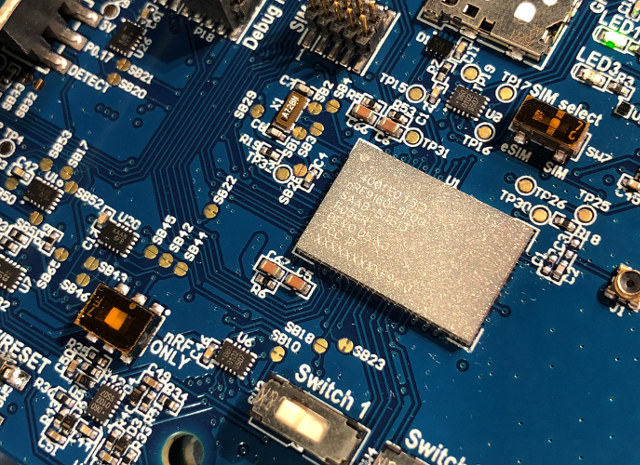Nordic Semi will soon launch nRF91 series low power cellular IoT solution, that consists of a system-in-package (SiP) combining a global multimode LTE-M / NB-IoT modem, an Arm Cortex-M33 core, Arm TrustZone security solution, assisted GPS, and flash memory into a 16x10x1.2 mm package.

Nordic Semi nRF91 specifications known to far:
- CPU – Arm Cortex-M33 ARMv8-M host processor
- Memory / Storage – Built-in RAM and flash Memory
- Connectivity
- Multimode LTE-M (eMTC) and NB-IoT modem by Nordic
- SAW-less transceiver
- Custom RF front-end solution from Qorvo.
- Location – Optional assisted GPS combining cellular and GPS technology for fast and accurate positioning
- Security – Arm TrustZone security via Arm CryptoCell-310 security IP
- Power Management
- Package – 16 x 10 x 1.2 mm
Nordic Semiconductor nRF91 Series is said to include a complete suite of software and development tools for product development, but no details were provided at this stage.
The solution has already been demonstrated on the Verizon Wireless Network in the U.S. and on the Telia network in Norway, and nRF91 samples are being sent to select customers. However, we’ll have to wait a little longer before seeing products based on nRF91, as general samples are only planned for mid-2018, and mass production for the end of the year.

Jean-Luc started CNX Software in 2010 as a part-time endeavor, before quitting his job as a software engineering manager, and starting to write daily news, and reviews full time later in 2011.
Support CNX Software! Donate via cryptocurrencies, become a Patron on Patreon, or purchase goods on Amazon or Aliexpress. We also use affiliate links in articles to earn commissions if you make a purchase after clicking on those links.




Looks like Nordic didn’t publish the slides they used in their presentation, you can get screencaps in my Twitter thread: https://twitter.com/arturo182/status/955473262984785921 There’s more info about both the SiP and MCU, power consumption and timeline.
@arturo182
Thanks, that’s nice set of slides. I wish Nordic would have shared those in their press release…
I would love to have a cost effective cellular solution. The existing solutions of $40 modules or chips that you need to spend $500,000 getting certified onto a cell network are not going anywhere except in a few, high-value use cases.
The potential market for cellular IOT is huge, but it is also very price sensitive. And so far the cell ISPs haven’t done much to get costs down to a point where their solutions are attractive.
Give me a $5 chip, a $1/mth data charge and no big bill for certification and I’ll put one in every device we make.
@Jon Smirl
Based on the info I have NB-IoT hardware should be a bit more expensive than hardware for LoRa or Sigfox, but maybe you don’t have that option in the US, or at least coverage may not be expansive enough.
In Thailand, one of the telcos currently sells a devkit for $60 for NB-IoT, but I could not get information about the module price when asked.
Data charge already matches your target here. If I remember correctly, it’s 350 Baht ($11) per year for NB-IoT, 300 Baht for LoRa ($9.5), so maybe US telcos will be able to get close to that price too…
Sequans already makes a $6 chip but it has the $500,000 certification problem. So people put the $6 chip onto a module and get it certified. Of course those modules end up costing $40 to recover the $500,000 spent on certification. In general the module is just the addition of 10 cents worth of passives, the real reason is to control the license to work under the $500K certification. There is a very expensive racket going on with hooking devices to cell networks. My worry is that the nRF91 is going to need the $500,000 worth of certification costs. In general we are making progress, it used to cost $1M to get a phone certified. My personal opinion is that the level of certification required is ridiculous, instead the true purpose of these certifications is to keep low cost products out of the market.
The wifi market works differently. The implementations are certified to a standard instead of a per carrier certification. Then the certified implementation is distributed as firmware for the chips at no additional charge.
LTE is sort of moving in that direction. But you can still buy LTE phones, put in a SIM card, and then when you connect you may receive a “not certified” error message. It this really because of technical certification issues? Or is it being done to prevent the movement of phones from low cost markets into high cost ones? It is funny how these phones can roam onto the offending network, but you can’t make it your primary network.